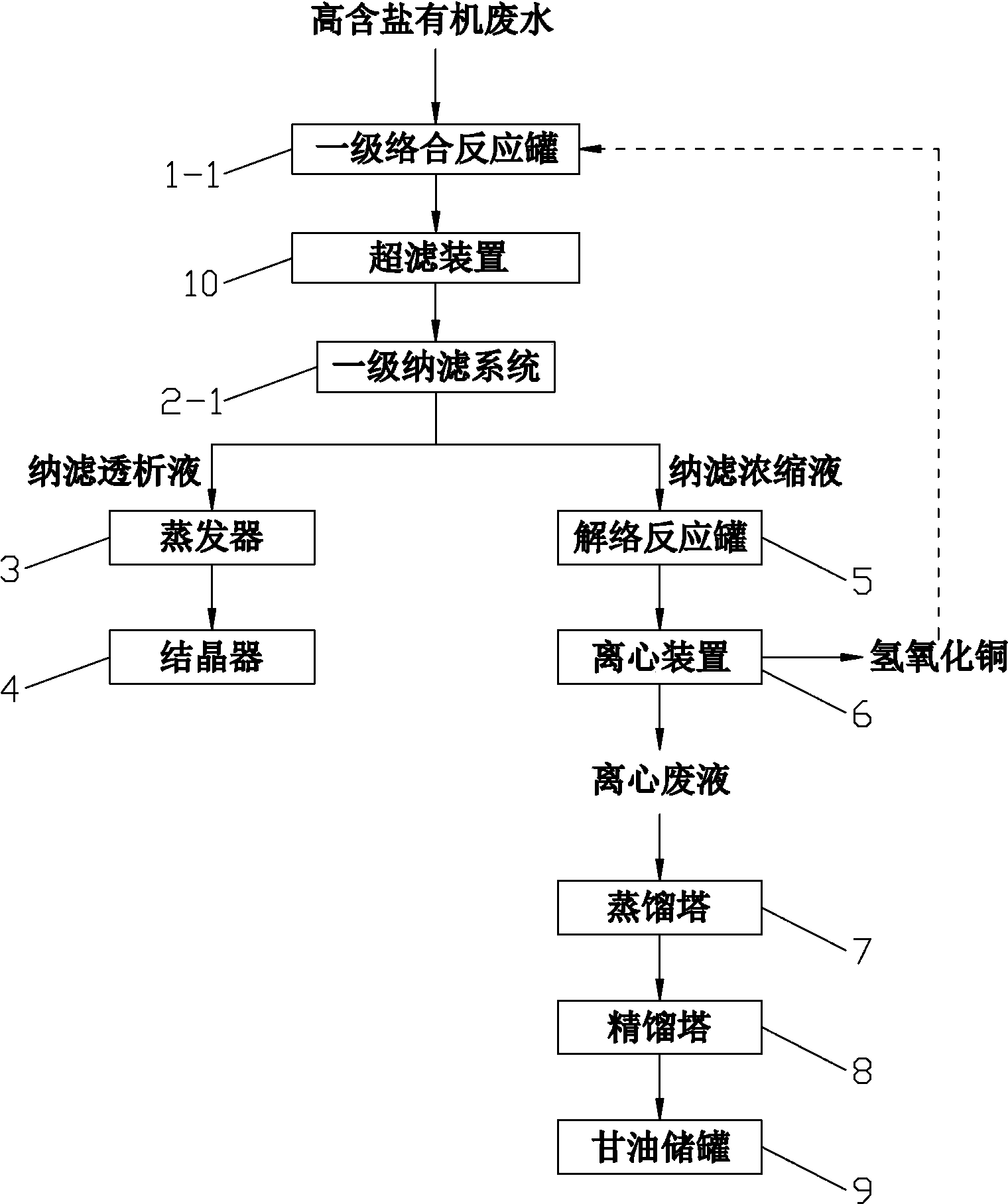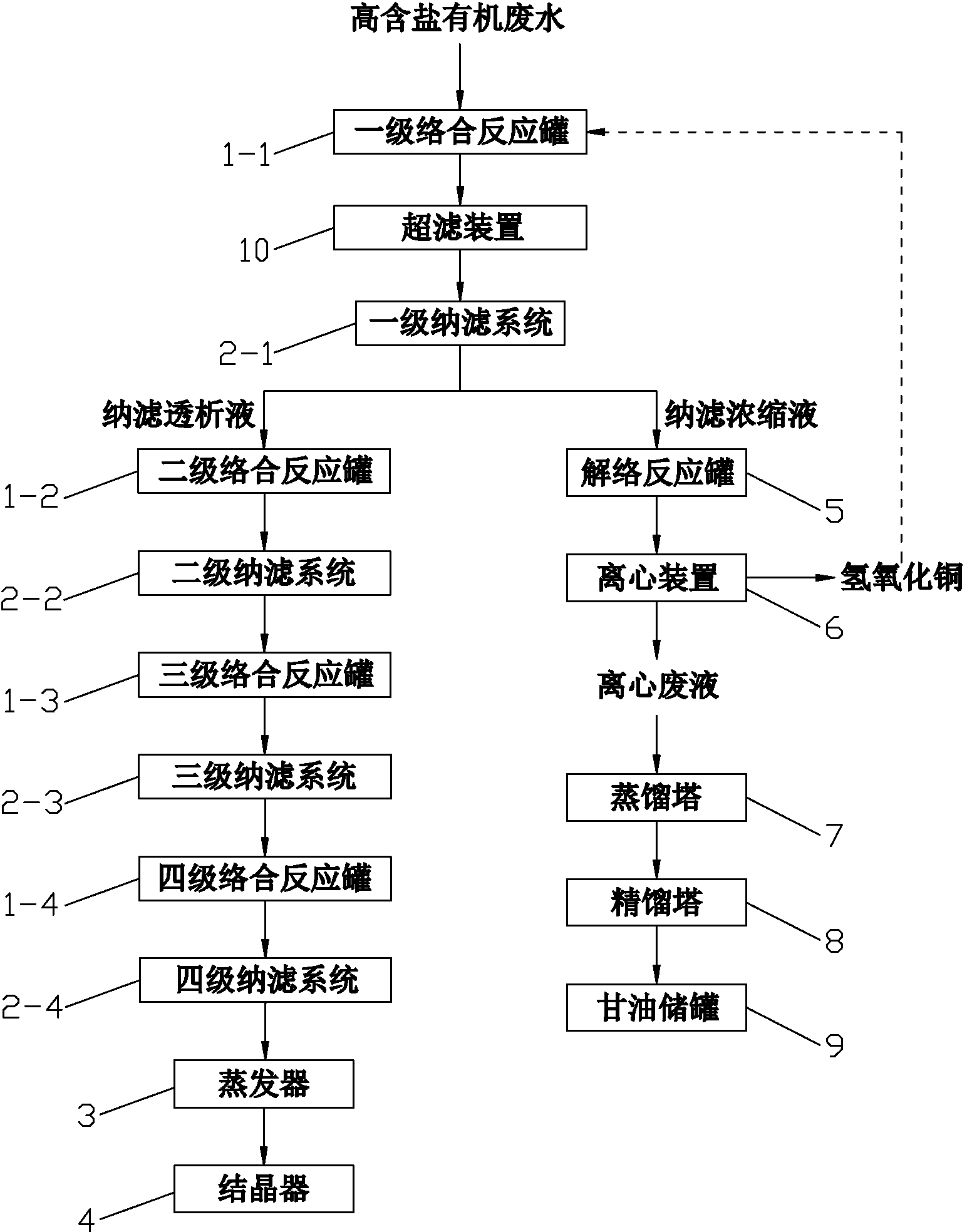Device for recovering glycerinum in high-salinity organic wastewater
An organic waste water and recycling device technology, applied in the preparation of organic compounds, organic chemistry, water pollutants, etc., can solve the problems of waste of resources, pollute the environment, and have not been recycled, and achieve the effect of ensuring feasibility
- Summary
- Abstract
- Description
- Claims
- Application Information
AI Technical Summary
Problems solved by technology
Method used
Image
Examples
Embodiment 1
[0034] refer to figure 2 , Recover sodium chloride and glycerin from waste water containing 30% sodium chloride and 2% glycerin.
[0035] (1) Primary complexation
[0036] Introduce high-salt organic wastewater into the primary complexation reaction tank 1-1, and add sodium hydroxide solution and copper sulfate solution, so that the glycerol contained in the wastewater undergoes a complex reaction with copper ions under alkaline conditions to form a negative Divalent glycerol copper complex.
[0037] (2) Primary nanofiltration desalination
[0038] The waste water after the complexation treatment in step (1) enters the first-level nanofiltration system 2-1 for filtration and desalination to obtain the nanofiltration concentrate containing copper glycerol and the nanofiltration dialysate containing sodium chloride, and the dialysate contains sodium chloride 19%, analyzed by liquid chromatography, the glycerin content is 350mg / L. In order to ensure that the nanofiltration m...
Embodiment 2
[0054] refer to image 3 , Recover sodium chloride and glycerin from waste water containing 18% sodium chloride and 20% glycerol.
[0055] (1) Primary complexation
[0056] Introduce high-salt organic wastewater into the primary complex reaction tank 1-1, and add alkali hydroxide and copper hydroxide newly made from copper sulfate, and keep stirring so that the glycerol contained in the wastewater can be mixed with the alkaline condition under alkaline conditions. Copper hydroxide undergoes a complexation reaction to generate a negative divalent glycerol copper complex.
[0057] (2) Primary nanofiltration desalination
[0058] Make the waste water after the primary complexation treatment in step (1) enter the primary nanofiltration system 2-1 for filtration and desalination, and obtain the nanofiltration concentrate containing glycerol copper and the nanofiltration dialysis containing 15% sodium chloride and 8% glycerin liquid. In order to ensure that the nanofiltration me...
Embodiment 3
[0087] refer to Figure 4 , Recover sodium chloride and glycerin from waste water containing 22% sodium chloride and 12% glycerol.
[0088] (1) Primary complexation
[0089] Make the high-salt glycerol-containing wastewater enter the first-level complexation reaction tank 1-1, and add sodium hydroxide solution and copper sulfate solution, so that the glycerol contained in the wastewater undergoes a complexation reaction with copper ions under alkaline conditions to generate glycerol copper complexes.
[0090] (2) One-stage nanofiltration desalination (separation of copper glycerol and salt)
[0091] The wastewater after the complexation treatment in step (1) enters the first-level nanofiltration system 2-1 for filtration and desalination, and obtains a nanofiltration concentrate containing glycerin copper and a nanofiltration dialysate containing 17% sodium chloride and 4% glycerin .
[0092] (3) Secondary complexation
[0093] The nanofiltration dialyzate containing 17% ...
PUM
| Property | Measurement | Unit |
|---|---|---|
| retention rate | aaaaa | aaaaa |
Abstract
Description
Claims
Application Information
 Login to View More
Login to View More - R&D Engineer
- R&D Manager
- IP Professional
- Industry Leading Data Capabilities
- Powerful AI technology
- Patent DNA Extraction
Browse by: Latest US Patents, China's latest patents, Technical Efficacy Thesaurus, Application Domain, Technology Topic, Popular Technical Reports.
© 2024 PatSnap. All rights reserved.Legal|Privacy policy|Modern Slavery Act Transparency Statement|Sitemap|About US| Contact US: help@patsnap.com










